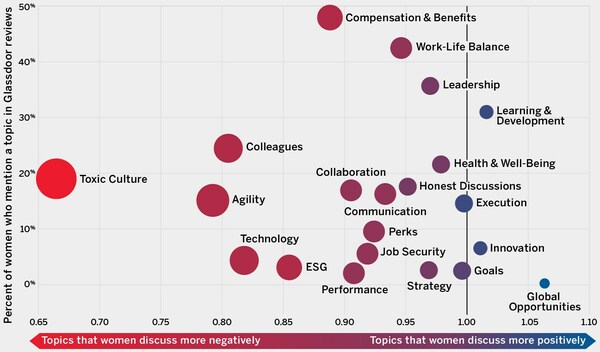The Toxic Culture Gender Gap has Widened Since the Pandemic
CAMBRIDGE, Mass., March 14, 2023: According to new research released today in MIT Sloan Management Review, women are 41% more likely than men to experience toxic corporate culture. The toll of the pandemic appears to have widened the toxic culture gender gap. Over the six years from 2016 to 2021, women were 35% more likely to negatively mention toxic culture compared to men.

“The compensation gap between women and men has rightly generated a lot of attention. National Equal Pay Day, which falls on March 14, 2023, highlights the difference in average compensation by marking the number of extra days a woman has to work to earn as much as her male counterpart,” said lead author Donald Sull, senior lecturer at the MIT Sloan School of Management and cofounder of CultureX, a company that uses AI to measure and improve corporate culture.
“For many women, the gender gap in toxic culture may have an even more profound impact on their day-to-day experience in the workforce. If an Equal Culture Day existed, based on the additional days of toxic culture that women suffer, it would occur on May 30 — more than two months after Equal Pay Day.”
In “Toxic Culture Gap Shows Companies Are Failing Women” Donald and Charles Sull examine which elements of corporate culture are most critical to women and where the biggest shortfalls in culture are. They found that women are slightly more critical of most elements of culture and the employee experience, like collaboration and work-life balance, than men. But one topic they studied had a much more pronounced gap than the others: toxic culture. The authors defined toxic culture as disrespectful, non-inclusive, cut-throat, abusive, and unethical behavior in their previous research.
“Toxic culture is not only an outlier in terms of the sentiment gap between women and men, it exacts an enormous toll on organizations and individuals,” continued Sull. “In our work advising firms on how to fix toxic cultures, we have found that leaders who successfully narrow the toxic culture gap begin by focusing on the employee experience and identifying and rooting out toxic behaviors across all levels of the organization through a sustained cultural detox effort.”
Why do women speak so much more critically about toxic culture than men? One might expect mentions of gender equity and sexual discrimination to account for most of the gap and women are indeed significantly more likely to negatively mention these topics than men. This accounts for a relatively small portion of the gap, though. The researchers found that women are also significantly more likely to negatively mention other kinds of diversity and inclusion — including racial, disabled, and LGBTQ+ equity, favoritism, disrespectful behavior, cutthroat competition, and abusive behavior than men.
Additional findings of note, include:
- The toxic culture gap does not appear to diminish with seniority. Across self-reported C-level roles, women are 53% more likely to experience toxicity than men—higher than the average across all job categories.
- The occupation of chef exhibits the largest gender gap in toxic culture in our data, with female chefs 81% more likely to experience toxic culture than their male counterparts.
- Chefs exhibit the largest gender gap in toxic culture in our data, and women chefs are nearly twice as likely to discuss toxic culture in their reviews.
- Fourteen of the sixteen occupations with the smallest toxic culture gender gap are jobs with a high percentage of female employees, including childcare workers, psychologists, social workers, and communication associates. Even in most of these cases, the toxic culture gender gap exists. It is just smaller.
- The four sectors with the largest toxic culture gender gap were retail, transportation, investment services, and restaurants. Investment services (including brokerages, venture capital, private equity, investment banking, and asset management) stand out among white-collar industries for the size of the gap between men and women experiencing toxic culture. It’s worth noting that more traditional financial institutions, including insurance firms, banks, and credit unions all have gaps below the average of all industries.
- The women in our sample used more than 14,000 distinct words, terms, and phrases to describe elements of a toxic culture, and the two most frequently mentioned were “favoritism” and “clique.”
- Women and men discuss one element of toxic culture–unethical behavior–with roughly the same frequency.

























